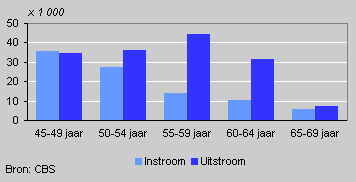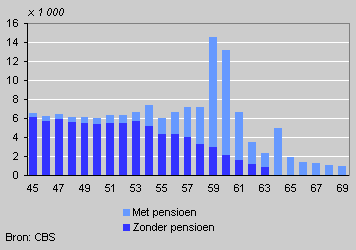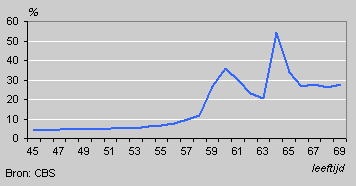Most employees retire around 60

The labour participation rate of older people increased in the period 1997-2003. The participation rate of people in the 55 to 59 age bracket rose significantly but also more people over 60 continued to work.
A further analysis reveals that inflow and outflow of older people on the job market is unevenly spread across the ages.
Inflow and outflow of older employees, September 2000-2001

Half of 45-69 year-olds retired
It turned out that over 150 thousand out of nearly 2 million employees aged 45 to 69 who were still working in September 2000 had left their job one year later. More than half of them retired in that period. On the other hand, more than 90 thousand jobless 45 to 69 year-olds had found a job in the same period.
Outflow outnumbers inflow from the age of 50
On balance, more people aged 45 to 49 entered than left the labour market. For women in this age category the inflow outnumbered the outflow, whereas for men it is the other way round.
More men and women aged 50 to 64 left than entered the labour market. A relatively limited number of 50 to 54 year-olds stopped working but in the age category over 55 the outflow was more substantial.
Outflow by age and source of income, 2000-2001

From the age of 58: mostly retired
Most people over 58 retire with a pension or some other kind of early retirement payment. Most of them retire around 60. The number of people round 60 who are still working falls sharply.
Thus 51 percent of 59 year-old men had a job in 2001, compared with only 25 percent of 61 year-old men.
Employees who stop working before the age of 58 usually do not receive a pension. Some of them receive a benefit.
Outflow of employees by age, 2000-2001

Irregular pattern
Early retirement schemes and pension deals cause the outflow to follow an irregular pattern. There are two obvious peaks in the outflow of employees: around the ages of 60 and 65.
Up to age 54, about 4 to 5 percent of workers leave the labour market, and up to age 58 this remains below 10 percent.
Then a rapid increase sets in. More than one third of employees who were 60 in 2000 no longer worked one year later. Most people who reach 65 stopped working a long time ago.
André Corpeleijn
Source: article ‘Oudere werknemers’